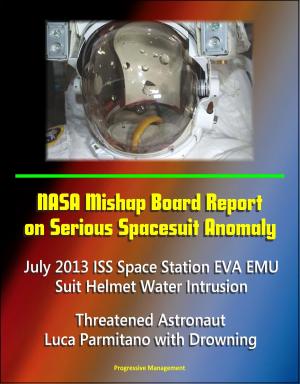Apollo and America's Moon Landing Program: Apollo 16 Technical Crew Debriefing with Unique Observations about the Fifth Lunar Mission - Astronauts Young, Duke and Mattingly
Nonfiction, Science & Nature, Science, Physics, Astronomy, History, Americas| Author: | Progressive Management | ISBN: | 9781466011274 |
| Publisher: | Progressive Management | Publication: | December 13, 2011 |
| Imprint: | Smashwords Edition | Language: | English |
| Author: | Progressive Management |
| ISBN: | 9781466011274 |
| Publisher: | Progressive Management |
| Publication: | December 13, 2011 |
| Imprint: | Smashwords Edition |
| Language: | English |
This official NASA document - converted for accurate flowing-text ebook format reproduction - provides the complete transcription of the Apollo 16 post-flight debriefing given by astronauts, with their first-hand description of the fifth moon landing - featuring the second use of the Lunar Roving Vehicle (LRV). This ebook is an invaluable addition to the library of anyone interested in the Apollo moon landings.
Contents include: SUITING AND INGRESS * STATUS CHECKS AND COUNTDOWN * POWERED FLIGHT * EARTH ORBIT AND SYSTEMS CHECKOUT * TLI THROUGH S-IVB CLOSEOUT * TRANSLUNAR COAST * LOI, DPI, LUNAR MODULE CHECKOUT * LUNAR MODULE CHECKOUT THROUGH SEPARATION * SEPARATION THROUGH LM TOUCHDOWN * LUNAR SURFACE * CSM CIRCUMLUNAR OPERATIONS * LIFTOFF, RENDEZVOUS, AND DOCKING * LUNAR MODULE JETTISON THROUGH TEI * TRANSEARTH COAST * ENTRY * LANDING AND RECOVERY * TRAINING * CSM SYSTEMS OPERATIONS * LUNAR MODULE SYSTEMS OPERATIONS * LRV OPERATIONS * EMU SYSTEMS * FLIGHT EQUIPMENT * FLIGHT DATA FILE * VISUAL SIGHTINGS * PREMISSION PLANNING * MISSION CONTROL * HUMAN FACTORS
Three primary objectives were (1) to inspect, survey, and sample materials and surface features at a selected landing site in the Descartes region; (2) emplace and activate surface experiments; and (3) conduct in-flight experiments and photographic tasks from lunar orbit. Additional objectives included performance of experiments requiring zero gravity and engineering evaluation of spacecraft and equipment.
The Descartes landing site is in a highlands region of the moon’s southeast quadrant, characterized by hilly, grooved, furrowed terrain. It was selected as an outstanding location for sampling two volcanic constructional units of the highlands – the Cayley formation and the Kant Plateau. The Apollo Lunar Surface Experiments Package, or ALSEP, was the fourth such station to become operational after Apollos 12, 14 and 15.
Orbital science experiments were concentrated in an array of instruments and cameras in the scientific instrument module, or SIM, bay. Handheld Hasselblad 70mm still and Mauer 16mm motion cameras were used by the crew. Minor changes in surface extravehicular activity, or EVA, equipment were evaluated – a stronger clutch spring in the television camera drive mechanism to eliminate aiming problems experienced on Apollo 15, longer seat belts on the Lunar Roving Vehicle for better astronaut retention, continuous fluting of drill bits to eliminate bit binding due to extracta jamming, and the addition of a treadle and jack to aid in drill core removal from the lunar subsurface.
A significant addition to surface objectives was an ultraviolet stellar camera to return photography of the Earth and celestial regions in spectral bands not seen from Earth. Evaluation of the lunar rover through a “Grand Prix” exercise consisting of S-turns, hairpin turns and hard stops also was to be conducted. A final orbital objective was to launch a subsatellite into lunar orbit from the command and service module, or CSM, shortly before transearth injection.
This official NASA document - converted for accurate flowing-text ebook format reproduction - provides the complete transcription of the Apollo 16 post-flight debriefing given by astronauts, with their first-hand description of the fifth moon landing - featuring the second use of the Lunar Roving Vehicle (LRV). This ebook is an invaluable addition to the library of anyone interested in the Apollo moon landings.
Contents include: SUITING AND INGRESS * STATUS CHECKS AND COUNTDOWN * POWERED FLIGHT * EARTH ORBIT AND SYSTEMS CHECKOUT * TLI THROUGH S-IVB CLOSEOUT * TRANSLUNAR COAST * LOI, DPI, LUNAR MODULE CHECKOUT * LUNAR MODULE CHECKOUT THROUGH SEPARATION * SEPARATION THROUGH LM TOUCHDOWN * LUNAR SURFACE * CSM CIRCUMLUNAR OPERATIONS * LIFTOFF, RENDEZVOUS, AND DOCKING * LUNAR MODULE JETTISON THROUGH TEI * TRANSEARTH COAST * ENTRY * LANDING AND RECOVERY * TRAINING * CSM SYSTEMS OPERATIONS * LUNAR MODULE SYSTEMS OPERATIONS * LRV OPERATIONS * EMU SYSTEMS * FLIGHT EQUIPMENT * FLIGHT DATA FILE * VISUAL SIGHTINGS * PREMISSION PLANNING * MISSION CONTROL * HUMAN FACTORS
Three primary objectives were (1) to inspect, survey, and sample materials and surface features at a selected landing site in the Descartes region; (2) emplace and activate surface experiments; and (3) conduct in-flight experiments and photographic tasks from lunar orbit. Additional objectives included performance of experiments requiring zero gravity and engineering evaluation of spacecraft and equipment.
The Descartes landing site is in a highlands region of the moon’s southeast quadrant, characterized by hilly, grooved, furrowed terrain. It was selected as an outstanding location for sampling two volcanic constructional units of the highlands – the Cayley formation and the Kant Plateau. The Apollo Lunar Surface Experiments Package, or ALSEP, was the fourth such station to become operational after Apollos 12, 14 and 15.
Orbital science experiments were concentrated in an array of instruments and cameras in the scientific instrument module, or SIM, bay. Handheld Hasselblad 70mm still and Mauer 16mm motion cameras were used by the crew. Minor changes in surface extravehicular activity, or EVA, equipment were evaluated – a stronger clutch spring in the television camera drive mechanism to eliminate aiming problems experienced on Apollo 15, longer seat belts on the Lunar Roving Vehicle for better astronaut retention, continuous fluting of drill bits to eliminate bit binding due to extracta jamming, and the addition of a treadle and jack to aid in drill core removal from the lunar subsurface.
A significant addition to surface objectives was an ultraviolet stellar camera to return photography of the Earth and celestial regions in spectral bands not seen from Earth. Evaluation of the lunar rover through a “Grand Prix” exercise consisting of S-turns, hairpin turns and hard stops also was to be conducted. A final orbital objective was to launch a subsatellite into lunar orbit from the command and service module, or CSM, shortly before transearth injection.















